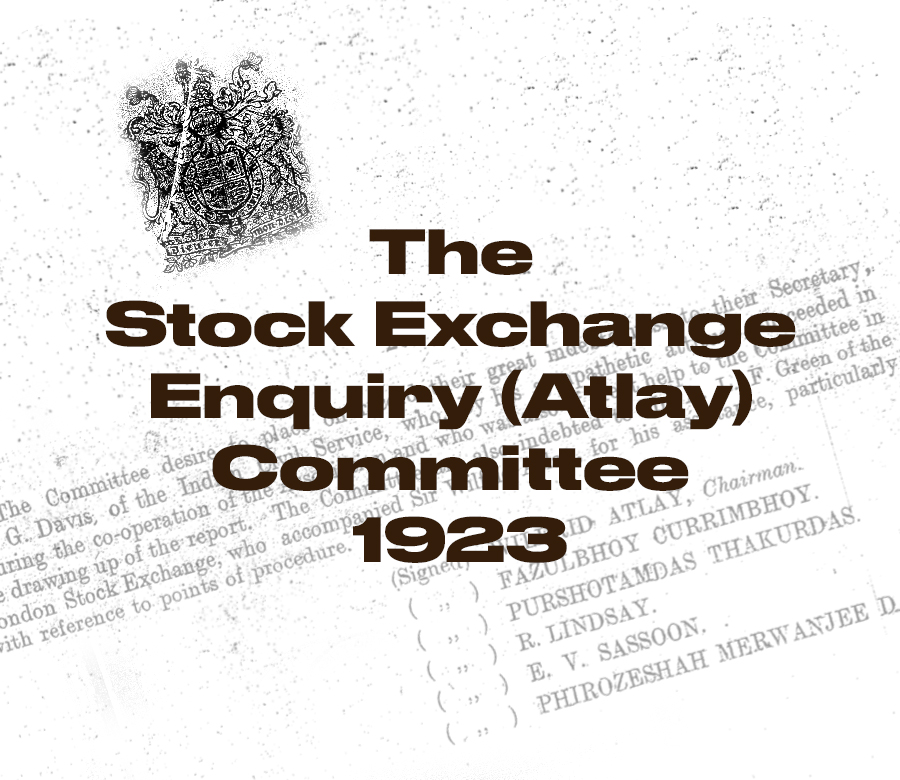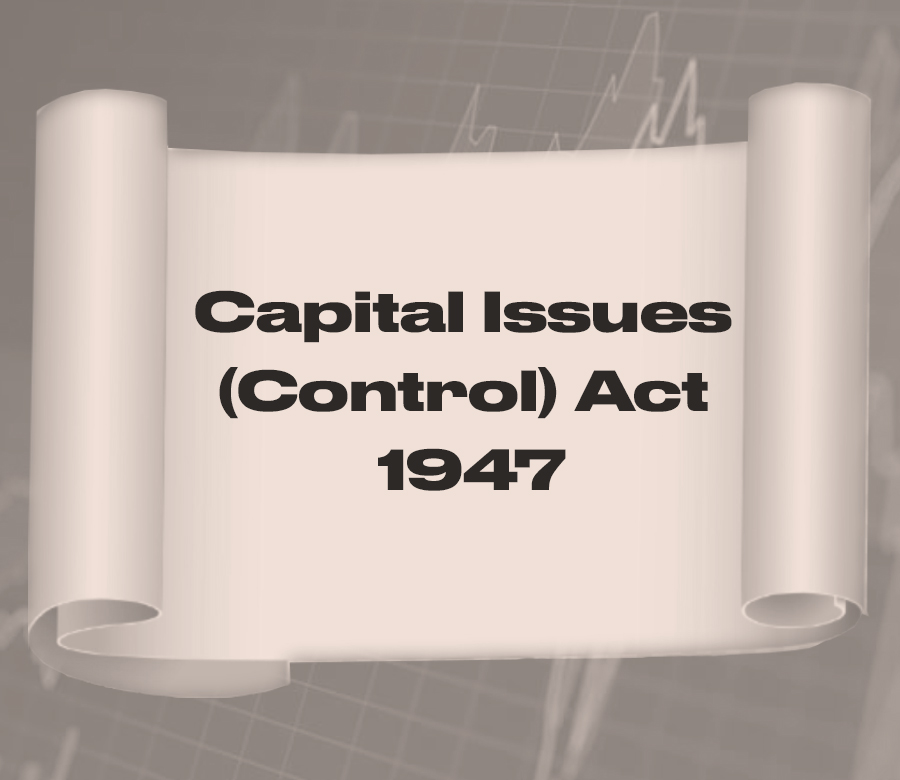Article Repository
Content Type
Category
Sort

Commodity trade: From Ancient Clay Tablets to Modern Electronic Platforms
The commodity trading world-wise has witnessed transformative shifts over the centuries. Ancient Mesopotamian clay tablet contracts established the foundation for commodity derivatives. Historical developments, from Japan's Dojima Rice Exchange to Chicago's CBOT, shaped commodity markets. In modern India, trading occurs on electronic platforms of recognized exchanges, namely MCX, NCDEX, NSE and BSE. Emergence of nation-wide electronic trading facility offered by national level exchanges and certain regulatory requirements led to closure of smaller or commodity specific exchanges. Over a period, the market regulator, (earlier Forward Market Commission and now SEBI) introduced several measures from time to time to deepen and broaden the market.

Indian Stock Market: Formative Years
The article titled “Indian Stock Market: Formative Years” provides a brief outline of the landmark events that are strongly etched in the historical timeline of the growth of securities market in India since the 17th century.

Premchand Roychand: The Rise, Fall, and Enduring Legacy of an Iconic Indian Stockbroker
During 19th century, Shri Premchand Roychand was a prominent personality in financial market in Mumbai (earlier known as Bombay). Born in 1831, he rose from a modest background to become a key player in the stock market, ultimately founding the ‘The Native Share and Stock Brokers Association (earlier known as Bombay Stock Exchange and now BSE). His career coincided with a period of economic growth in Mumbai, driven by factors like the American Civil War's impact on the cotton trade. Premchand's influence extended to banking and land reclamation projects, marking stages of prosperity. However, the end of the Civil War led to a financial downturn, and he faced criticism and financial ruin. Despite this, Premchand Roychand's legacy endures through his philanthropic contributions and the recognition of his impact on Mumbai’s development. A dedicated gallery in Chhatrapati Shivaji Maharaj Vastu Sangrahalaya, Mumbai has been established in his honor. University of Calcutta gives out an award in his name i.e. Premchand Roychand Award to an outstanding student in Master of Arts every year. The Rajabai clock tower in Mumbai is named after his beloved mother Rajabai Roychand.

Evolution of Company Laws in India
This article explores the historical evolution and significance of Indian Companies Acts from 1850 to 2013 in shaping corporate governance and the securities market in India. It highlights key milestones in the development of company laws, such as limited liability, mandatory audits, financial disclosures and the establishment of regulatory bodies like SEBI. The article also discusses the impact of these Acts on corporate governance practices, transparency, accountability, and investor protection. It emphasizes how these legal frameworks have facilitated economic growth and attracted investment, with iconic companies benefiting from the evolving regulatory environment. The Companies Act of 2013, with its modernization efforts, is seen as a turning point in promoting a transparent and investor-friendly corporate environment.

Calcutta: The Juteopolis of India
This article explores the celebrated history of the Calcutta jute industry, tracing its roots, its hegemony in the world markets and its decline. Starting in 1855 with the Acland Mill in Rishra, Bengal, the jute industry experienced significant growth under the managing agency system. The Indian Jute Manufacturers Association (IJMA), formed in 1884, fuelled prosperity of the industry until the end of World War I. The article goes on to explain how Calcutta outstripped Dundee, Scotland to become the capital of the global jute markets and the ensuing boom in jute shares market. It also discusses how the emergence of jute substitutes, age-old policies of IJMA and finally the partition of British India led the industry onto the path of decline. The article concludes by emphasizing the potential of jute as a sustainable and eco-friendly crop that could play a significant role in the world of tomorrow.

Cotton Boom and Bust: The Legacy of India's First Stock Market Crash (Share Mania of 1861-1865)
“… 50 million sterling, if not more, of real wealth had been allowed to disappear like the baseless fabric of a vision, and how on the debris of such fabric the Bombay (now known as Mumbai) of today was re-built…”- DE Wacha, A Financial Chapter in the history of Bombay City. The American Civil War, which took place during 1861 to 1865, had a profound impact on global cotton supplies. Amidst the crisis, India emerged as a crucial alternative source of cotton for the textile mills of Europe. The Bombay Presidency, in particular, played a pivotal role in supplying cotton to meet this growing demand. However, after the end of the American Civil War, the cotton bubble that had propelled Bombay into a frenzy of economic activity burst. This resulted in an unprecedented crash in both prices of cotton and those of shares of cotton companies. This article delves into the rise and fall of the Indian cotton industry, particularly in Bombay, during this tumultuous period. It explores the economic boom that saw cotton exports soar and the subsequent crash that left Bombay in financial ruins.

Journey of the BSE
The BSE is the oldest stock exchange in Asia and its origins can be traced back to the 1850s. The establishment of the BSE was influenced by various factors related to trade and business in Bombay (now Mumbai), which was a prominent commercial centre during British rule in India.
 Stock Market- A Historical Sketch.jpg)
Calcutta (Kolkata) Stock Market: A Historical Sketch
Calcutta (now known as Kolkata), the political and commercial capital of British India till 1911, boasted a thriving stock market activity that served as the nation's first financial hub. The establishment of Calcutta Stock Exchange (CSE) was a response to the growing need for official stock exchange. During the heyday, Calcutta provided a plethora of trading opportunities through three distinct stock exchanges, namely Calcutta Stock Exchange, Bengal Share and Stock Exchange, Stock Exchange Association of Bengal and informal exchanges at Gudri and Katni. However, with change in time, only CSE continued its operations and the other exchanges vanished/discontinued their operations long ago. The CSE enjoyed the status of one of the prominent stock exchange for a long time and also modernised its operations with introduction of electronic trading system, etc. However, the challenges emerged from payment crises of 2001 and the emergence of national level electronic trading platforms offered by BSE and NSE as a result of which CSE struggled to keep afloat. This eventually culminated in its trading suspension in 2013.

Overview of Commodity Derivatives Market in India
Over the centuries, commodity trading has evolved from the barter system to spot markets to derivatives markets. In commodity spot markets, traders sell goods such as rice for immediate delivery against cash. At some stage, counterparties needed to enter into agreements to deliver commodities (eg, rice) at a specified time in future at a price agreed today. These agreements came to be known as forward contracts. For example, on April 1, a seller agreed to sell rice of specific quantity for delivery on a future specified date say July 31 to the buyer at pre-decided price, the contract will be honoured by both the parties, irrespective of prevailing price of rice on July 31.
 on Stock Exchanges.jpg)
Impact of Bank Failures on Indian Stock Exchanges: A Case of ‘The Native Share and Stockbrokers’ Association’ (1913-1918)
The history of bank failures dates back to few centuries but recorded ones are as far back as 17th century. In the early 20th century, the world's financial landscape underwent significant transformation. As nations braced themselves for the impending chaos of World War I, India's economy had to confront multiple set of challenges. One of the most significant economic events during this period was the series of domestic bank failures between 1913 and 1921, which left an indelible mark on Indian stock exchanges. A notable case during this period was that of a prominent member of the Native Share and Stock Brokers Association (earlier known as Bombay Stock Exchange and now BSE), Mr. Jahangir Byramji who had a substantial holding in Manekji Petit Mill shares.

Overview of Equity Market
Equity markets comprise of the ecosystem and processes through which, investors buy and sell shares of publicly traded companies and also through which companies (listed and unlisted) raise capital from public/selected shareholders. Equity Shares, or commonly called as shares, represent a share of ownership in a company. An investor who invests in shares of a company is called a shareholder, and is entitled to receive all corporate benefits, like dividends, capital appreciation, bonus shares, etc of that company.
-A Historical Journey.jpg)
Madras Stock Exchange (MSE): A Historical Journey
Madras Stock Exchange, established in 1920, was the first in the southern part of India. MSE played a notable role in the growth of industries in the southern region. By observing strict rules of conduct and ensuring high professional standards, MSE earned its esteem among the investing public as well as the entrepreneurs. In 1957, the Exchange registered itself under the Companies Act, 1955 and became a company limited by guarantee. The Exchange was converted as a company limited by shares and obtained re-registration on November 18, 2005. MSE ensured to keep up with the technological advancements happening in the sphere of business. However, the expansion of national stock exchanges and the spread of their terminals all over India affected MSE, as it did any other regional stock exchange. MSE in 2001 established its subsidiary company, MSE Financial Services Ltd and acquired membership of NSE and BSE, through a provision provided by SEBI to the regional stock exchanges to revive their business. However, MSE decided to exit the stock exchange arena in 2014 and the same was stamped by the exit order passed by SEBI on May 14, 2015.

The Stock Exchange Enquiry (Atlay) Committee in 1923
This article outlines the background leading up to the constitution of the Enquiry Committee in 1923 chaired by Sir Wilfrid Atlay to look into the affairs of functioning of the Native Share and Stock Brokers’ Association in Bombay. The article goes on to describes some of the major observations made by the Committee, issues underlined by the Committee concerning the business of the Association and lists important recommendations given by the Committee.

Impact of Great Depression on Indian Stock Market, 1929
The Great Depression was the deepest and the longest economic downturn of the 20th Century that affected most of the major economies of the world. India, being a colonial export oriented economy was also adversely impacted by the Great Depression primarily due to crash in commodity prices in domestic and international markets. Further, stocks plummeted on major Indian exchanges, taking cues from global turmoil. However, by 1932, normalcy was restored in international trade and manufacturing activity and there was a sizable recovery in India as well. The article delves into the events leading to the Wall Street crash of 1929, the subsequent global economic depression and the impact of these events on the Indian economy.

The Morison Committee Report on the Stock Exchange Inquiry, 1936
In 1936, forward trading was suspended. Consequently, the investing public faced huge losses and brought criticism to the exchange. This led to the Governor in Council appointing the Stock Exchange Enquiry Committee under the chairmanship of Walter B. Morison vide a resolution dated 24th November 1936 to examine the working of the Native Share and Stock Brokers’ Association of Bombay (earlier known as Bombay Stock Exchange and now BSE) and to submit any suggestions for modifications or reorganization of the stock exchange in the interest of investors. The Morison Committee Report is a significant chapter in the history of Indian stock exchanges, shedding light on the initial attempts at reforming and structuring the market for enhanced transparency and investor protection.
Stock Exchange Enquiry Committee – Walter B Morison
The Committee was constituted in 1937 by Government of Bombay with Mr. Walter B Morison as it's Chairman. The committee was required to consider whether any modifications in the working of the Native Share and Stock brokers' Association are desirable in the interests of the investors and to make recommendations for the same. Some of the key recommendations included limiting powers of intervention to the Board of Directors in the natural course of the market, strengthening of rules in regard to defaulters and remisiers, institution of margin deposits, prohibition of speculative dealings for employees, etc.

Capital Issues (Control) Act, 1947
The Capital Issue (Control) Act, 1947 was the pivotal act governing the issuance of capital by corporates from 1947 to 1992, until economic reforms and new economic policy in India replaced the remit this piece of legislation with that of the SEBI Act, 1992. This article explores the origin, evolution and role of Capital Issues (Control) Act, 1947.
Capital Issues (Control) Act, 1947
The Capital Issue (Control) Act, 1947 was the pivotal act governing the issuance of capital by corporates from 1947 to 1992, until economic reforms and new economic policy in India replaced the remit this piece of legislation with that of the SEBI Act, 1992. This article explores the origin, evolution and role of Capital Issues (Control) Act, 1947.
.jpg)
Transformation and Regulation of the Indian Stock Market (With Insights from the P.J. Thomas Report of 1948)
The Government of India set up a departmental enquiry headed by Dr. P J Thomas, Economic Adviser to the Ministry of Finance. The Committee was constituted to submit a report on a suitable law to regulate the stock exchanges in India as speculative activities during and after World War II were increasing in spite of promulgation of Defence of India Rules, which was also about to lapse. Dr. Thomas’s report of 1948 aimed to bring about comprehensive reorganization, establishing a regulatory environment to safeguard against unhealthy speculation and manipulative practices. Towards accomplishing these, the Committee recommended promulgation of a central legislation and the setting up of a competent public authority to administer the law. Based on the recommendation of this Committee, a draft Bill on stock exchange regulation was prepared by the Government in 1951 which was then referred to an expert committee under the chairmanship of Mr. A.D. Gorwala. Subsequently, on the recommendations of the Gorwala committee, the Securities Contracts (Regulation) Bill, 1954 was formulated, which led to the promulgation of the Securities Contract Regulation Act (SCRA) 1956.
.jpg)
SCRA, 1956 – An Act to Prevent the Undesirable Transactions in Securities (With Insights from the Gorwala Committee Report)
Post second world war, boom in share prices had put stock exchanges into the spotlight of attention. As India adopted its Constitution in 1950, stock exchanges became a subject of Central Government. Simultaneously, a bill for regulation of forward contracts was introduced in the Parliament and the same did not cover trading in securities. In this background, in order to assist the Government in formulating legislation for the regulation of stock exchanges and of contracts in securities, the Government of India had appointed a committee headed by Mr. A D. Gorwala during 1951. The Committee was mandated to submit revised draft bill with proposals to regulate stock exchanges. The Committee submitted its report and draft bill in July 1951. The summary and recommendations of the committee were presented in Parliament on October 6, 1951. Acting on these recommendations, the Securities Contracts (Regulation) Bill was introduced in Parliament on December 24, 1954. Thereafter, the Securities Contracts (Regulation) Act was passed in 1956, with the accompanying Securities Contracts (Regulation) Rules enforced in 1957, for regulation of stock exchanges. The report devoted one chapter on the constitution of Stock Exchange Commission for exercising functions and discharge duties assigned under the proposed Act, namely, SCRA. This suggestion was upheld by many subsequent committees in their reports, until the formation of Securities and Exchange Board of India (SEBI) in 1988.


